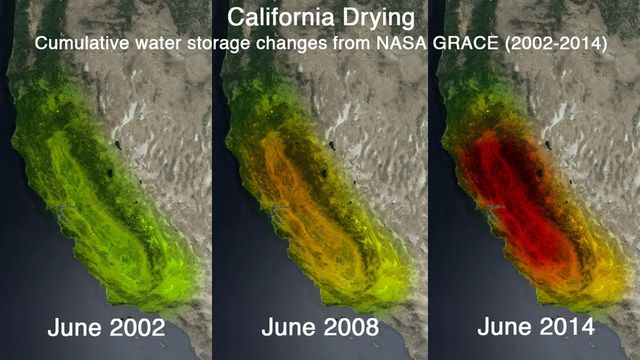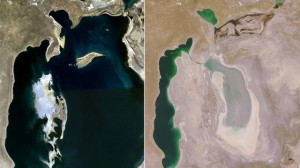Podcast: Play in new window | Download
Subscribe: RSS

Gravity sensing satellites have measured the withdrawal of water from the aquifer underlying California’s Central Valley. It’s almost over. (NASA images)
In more than 500 households in Tulare County, California, over a thousand people have been without running water for months. The reason you have not heard much about them is that they are poor working immigrants who labor in the Central Valley’s pastures of plenty to give us this day our daily lettuce and cilantro. They are homeowners whose homes are now worthless, dreamers of the American Dream who are now forced to buy bottled water to drink, to shower from coffee cans and flush with buckets filled at community tanks (with water from wells in imminent danger of going dry). Children are being kept home from school because they are too dirty. Proud cooks are feeding their families from cans. One resident told the New York Times (in a rare example of industrial media paying attention) “It’s a slow-moving disaster that nobody knows how to handle.”
There are 600,000 wells in the Central Valley, of which 100,000 are expected to run dry within 60 days in the absence of heavy rains. Which have been absent for three years and show no sign of returning. There are no weather forecasts indicating any relief on the way this fall or this winter. Data from gravity-sensing satellites show that the Central Valley has been depleting its ground water at the rate of four trillion gallons a year for three years now.
[A moment for the theoretical underpinnings of the phenomenon: Lewis’s First Law of Consumerism states, “If you have a bunch of stuff, even a whole bunch, and you use or lose a bunch of it every day, one day soon there will be no stuff left.” The formula expressing this is Sx – LSx = 0, where S = Stuff, LS is Lost Stuff and x is any damn number you want it to be.]
Most of the depletion (80%) is for the benefit of industrial agriculture, which chose this desert valley to be the nation’s source of lettuce, almonds, and a plethora of the world’s most thirsty crops. It takes a gallon of water to grow one almond, and 99% of the US almond supply comes from the Central Valley. And while some half a million acres of the valley’s cropland was left idle this year, farmers who can afford it are responding to the drought by drilling deeper wells and sucking harder.
Not that they have any options; they are drilling for water, going down 2,000 feet and more, because the vast, complex infrastructure of pipelines and canals that brings them surface water has virtually collapsed. Without water they will go bankrupt, so they will pump, faster and faster, until the end.
And California is far from alone. Those NASA gravity-sensing satellites reveal that every major aquifer under every major agricultural region in the world is being drawn down at unsustainable rates. Some of the aquifers could be replenished by abundant surface water in several decades; others are so-called fossil water, deposited eons ago by geological processes, and simply cannot be replaced.

The Aral Sea just ten years ago (left) and today. (NASA images)
Another example; the eastern Aral Sea in Kazakhstan, once, with an area of 23,000 square miles, the fourth-largest lake in the world. It’s empty. Diversion of water for the cotton-growing industry that surrounds it, along with prolonged drought imposed by a changing climate, has finished it off, as NASA satellites confirmed late this summer. It is now a dusty plain — its dust made toxic and carcinogenic by the effluent from chemical-intensive cotton farming — littered with the skeletons of great fishing boats.
As the great majority of people and their leaders continue to whistle past the graveyards of lakes, rivers and aquifers, hoping against hope for a commutation of their sentence to an arid Hades, the satellites’ unblinking gaze from space shows us, over and over, exactly where and when the whistling stops.
Tlaloc’s displeasure with humanity at present must be profound. In some places around the world he sends way too much rain, in others none at all.
He’s still okay with Singapore for the time being. (Here we try and catch as much of the rainwater as we can, plus do a lot of desalination of seawater and purification of used water, all through the expenditure of nonrenewable energy resources. We’re also encouraging everyone not to waste water.) But no one knows how long this can last, given what’s happening all around the world courtesy of our collective industrial way of life. Even if the Great Tlaloc continues making the waters run on our tropical island, it will not do much good if he withdraws his blessings from too much of the rest of the world — from which our island imports around 90% of its food…
This damn blog is the intellectual equivalent of fermented cod liver oil. It provides essential cognitive nutrients but NO amount of sugar is going to help this medicine go down.
http://www.biologicaldiversity.org/news/press_releases/2014/fracking-10-06-2014.html – There’s nothing left to do but laugh…